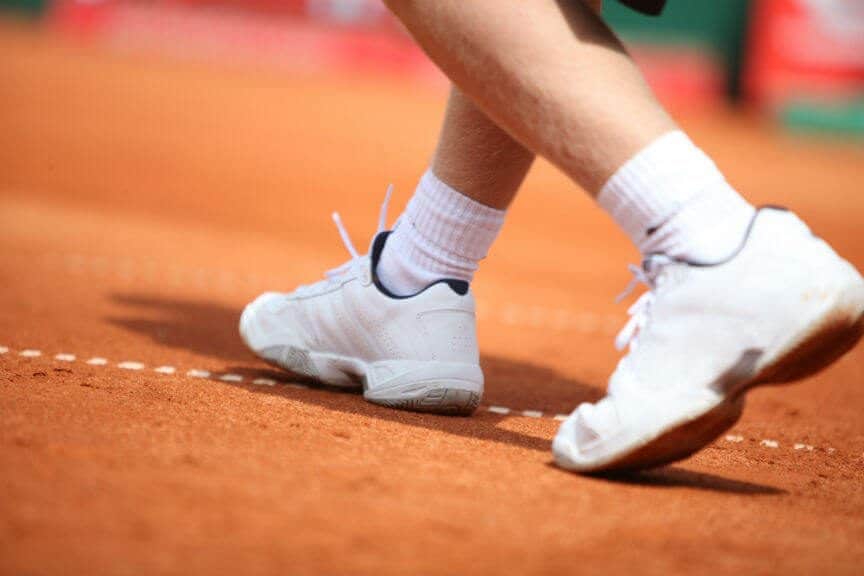If you are new to the game and already own a pair of cross trainers for other sports or exercise, you may be wondering if they will work for tennis as well. The thinking here is that they are made for multi-directional movement and provide good overall support.
Cross trainers can work in tennis in terms of support for lateral movement. However, the outsoles are generally thinner and the insoles are less padded. They will not last long or provide adequate cushion if used regularly on a tennis court. In a fallback situation where you don’t own a pair of proper tennis shoes, cross trainers can work, assuming you will not be playing with them for too long or too intensely.
Over the long term, you want to own a proper pair of tennis shoes. Cross trainers are definitely a better option than running shoes, which should never be used on a tennis court. Running shoes are made for forward movement only, you can injure yourself using them to play tennis.
If you have a couple of pairs of cross trainers, opt for the ones with better foot cushioning. Avoid the low heal minimalist type trainers. These will not work well on a tennis court. Tennis shoes have fairly padded insoles to absorb impact on hard court surfaces.
Differences between Cross Trainers and Tennis Shoes
Cross trainers, as their name suggests, are designed to work for many sports and athletic activities. They provide adequate performance for a wide range of sports, but at the same time, they do not excel for any particular one, particularly specialized sports such as tennis.
They differ from running shoes in that they are more level to the ground. Unlike running shoes that have a high heel drop and more padding in the forefoot area to absorb impact, cross trainers are more level to the ground to allow for movement in various directions.
This aspect of cross trainers does work well for tennis. Multi-directional movement is important in tennis, particularly lateral movement. However, there are other features that tennis shoes have that are lacking in cross trainers.
Added Lateral Support
Lateral movement in tennis is a big part of the game. Tennis shoes, therefore, are specifically designed to support extensive side-to-side movement on the court while at the same time protecting your feet and ankles from injury.
They are typically designed with features that strengthen the sides and forefoot portion of the shoes. The sides of tennis shoes tend to be more rigid. Compared to cross trainers, tennis shoes offer a higher degree of support for lateral movement.
The rigidity of the sides and stability in the forefoot region that characterizes tennis shoes are important because tennis involves a great deal of abrupt stop and go, sliding, and movement in various directions. Tennis shoes tend to have very firm lateral side reinforcement to prevent the uppers from ballooning under these conditions.
Outsole Differences
Tennis shoes also tend to have a narrower and thicker outsole. This provides greater durability on hard court surfaces as well as greater maneuverability. The problem with cross trainers is that the outsoles tend to be wider. This is what provides lateral stability in these types of shoes.
The wide base in cross trainers complicates lateral movement on a tennis court, particularly on a hard surface, and makes sliding more difficult. In tennis grip is important, but at the same time, some sliding is necessary. Tennis shoe soles provide a balance between the two.
The tread pattern on tennis shoes is also more intricate than on cross trainers. A thin herringbone pattern is common among tennis shoes to provide traction, while cross trainers tend to have larger treads for gripping surfaces.
Another important thing to consider is that the soles of cross trainers can mark up a court. For this reason, sometimes they are not allowed. The soles of tennis shoes will not have this problem since they are non-marking and created for court use.
Midsole Differences
Midsoles for tennis shoes tend to be more generously padded than cross trainers. The reason for the extra padding is that they are designed to work on hard surfaces where the impact on the heel and other parts of the foot are significant.
Cross trainers are designed more for training indoors on wood surface courts or gyms rather than hard outdoor surfaces. For this reason, they are less padded and offer less support than tennis shoes which are specifically designed for outdoor use.
That’s not to say cross trainers can’t be used on outdoor surfaces, they can, but they will not be as durable and will not offer the necessary shock absorption when subjected to heavy pounding on a hard court for extended periods of time.
Weighting Differences
Tennis shoes are specifically designed to be a bit heavier than running shoes or cross trainers. This is to provide greater stability and also due to the fact that they are designed with thicker outsoles for added endurance.
While there are tennis shoes that are specifically made to be lighter (speed-oriented tennis shoes), they will still be a bit heavier than running shoes or cross trainers. These types of tennis shoes also tend to have thinner uppers, less cushion, and be less durable.
Nonetheless, lightweight tennis shoes can be a better alternative to cross trainers for those that prefer a lighter and more flexible shoe. An example of lightweight shoes are the Adidas Adizero Ubersonic.
Toe Guard / Toe Cap
Tennis involves a good amount of toe dragging. This typically occurs on serves or other overhead shots. For this reason, tennis shoes are specifically designed to prevent damage to the uppers of the shoe due to dragging.
Cross trainers sometimes have toe guards. Sometimes they don’t. Regardless, they are not designed for heavy dragging on a hard court surface. Tennis shoes, on the other hand, are designed with this purpose in mind.
Heal Counter and Ankle Support
In addition to lateral support, tennis shoes are going to provide better stability in the heel region. The constant stop and go nature of tennis requires a good heel counter and a stable collar to support the ankle. Good tennis shoes provide these features.
Another feature that some tennis shoes have is an attached tongue. This helps to reinforce the support around the ankle. While putting on a shoe with an attached tongue takes some getting used to, the ankle region will feel more locked in place and secure.
Final Notes
As has been discussed, cross trainers can be used in a fallback situation. However, they should not be used long-term or for intense play. Tennis shoes are specifically crafted to support the feet during abrupt stop and go and left-to-right lateral movement on the court.
If you find tennis shoes to be too clucky or weighted, there are options. Rather than opting for the cross trainers, look for a pair of lightweight or speed-oriented tennis shoes. They will provide better support and provide features specific to the game of tennis.
If you come across a pair of trainers and find them to be cheaper in terms of cost, pass up the temptation to buy. You are much better off getting a pair of proper tennis shoes. They will better support your feet and your game over time
Share this Post

